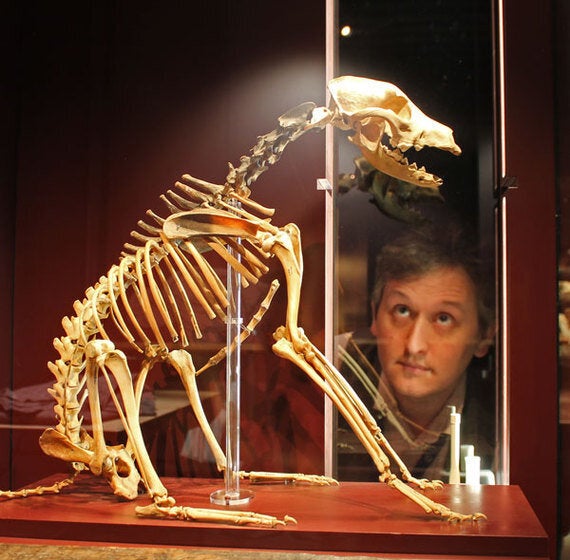Recently I asked our museum volunteers to tell us some of their stories about visitors and the collection, with the intention of collecting them for a follow-up to this blog from last year. This particular one stood out...
"Sometime during my early days as a volunteer I was on duty one Saturday morning in the main deck West Gallery. A young lad, possibly about six years old or so was becoming increasingly frustrated and animated whilst positioned next to 'Hatch', the ship's dog.
I was about to go over to check on his well-being when suddenly his face lit up and he could hardly contain his excitement when a lady entered the gallery he exclaimed, "look mummy ... look!!! Baby dinosaur in the cage!!!!"."
Rather a sweet story, and one that sounded familiar. A lot of our much younger visitors (plus a few older ones) seem to think, initially at least, that Hatch is a dinosaur. While you'd like to think most children in the UK know that there are 65 million years between the Mary Rose and the last non-avian dinosaurs, I have a theory that this has less to do with ignorance and more to do with how animals are generally displayed in museums.

Simon Clabby looking at the Mary Rose Museum exhibit of Hatch, the dog on board the Mary Rose.
When children go to natural history museums, all the modern animals, lions, crocodiles, dolphins, elephants, etc. tend to be represented as living animals, either through photographs, video, models or taxidermy. Sometimes a skeleton will be on display nearby, to talk about the similarities to human anatomy, but that's not very common. Therefore, in their minds something like a dog would look like a living dog.
When you see dinosaurs in a museum setting, they're almost always represented as a skeleton, which makes sense as that's generally how we find them. Some museums do have reconstructed models of dinosaurs, but the emphasis is still on mounted skeletons, so children associate skeletons with dinosaurs.
Therefore, when a child enters a museum, and sees an animal represented by a skeleton, it's understandable for them to assume that it's probably a dinosaur, as that's the norm for museums. Of course, it should also be logical to assume that there probably wasn't a dinosaur on a 16th century warship, but heh ho...
But again, that's another example of how children perceive museums, based on how they've experienced them in the media. There's a fascinating series of blog posts by Jack Shoulder on Museums in Movies, which notes that many movie museums have, shall we say, 'eclectic' displays. In mass media all museums are shown as displays of all history, so if the Gotham Museum of Art has to have dinosaurs, why not a museum about Tudor life?
Is this a perception that's likely to go away any time soon? Probably not, but I'm sure that our team are going to enjoy hearing this for many years to come, and using it as an opportunity to talk to our visitors. Well, until I can convince the curatorial team to put a Triceratops skeleton in our events space...
